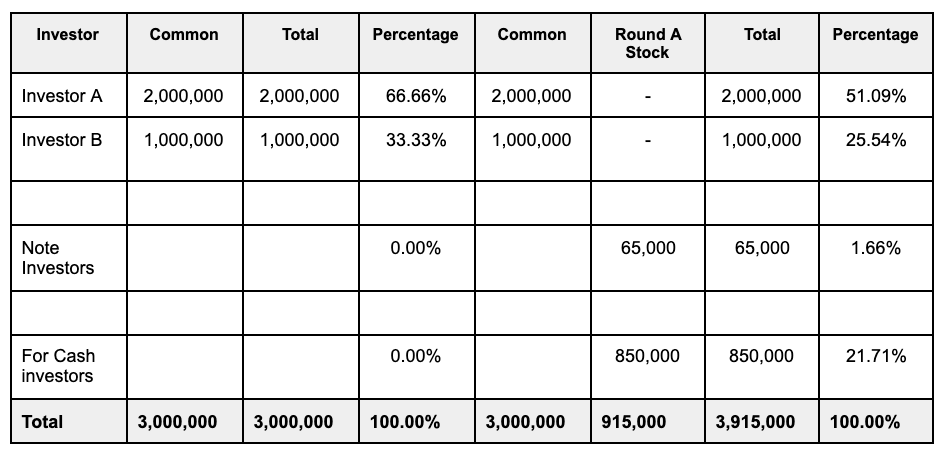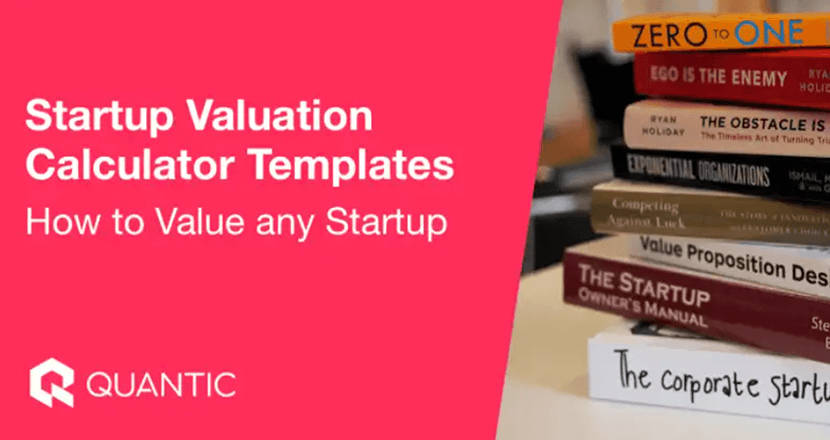ENTREPRENEURSHIP
Startup Valuation Calculator Templates | How to Value any Startup
Are you afraid of losing money and looking like a fool for making a bad investment? The answer is almost universally yes for every startup’s potential investors.
Fear causes an investor to second guess a sound opportunity staring them right in the face.
The best way to overcome investor fear is knowledge. The knowledge that the startup is valuable and will yield a solid return.
The first and best piece of knowledge is an accurate startup value. Let’s get familiar with the different methods of value calculations. We’ll define 7 different methods, how they work, and when you should use each one.
So download your free calculator below and follow along…

How to Value a Startup
There are many ways to calculate the value, but no magic number will meet every investor’s needs. The calculations break down into two major categories:
- Pre-money valuation
- Post-money valuation
Calculations are broken down based on when the payment happens. Usually it’s before and after the current rounds of funding.
Pre-Money Valuation
With this type of valuation, an investor estimates how much the company is worth right now. It’s an indicator of market confidence in the startup’s potential. It’s not necessary for even a single sale to be made.
This type of assessment can be more difficult to calculate because it depends on where the company is in its stage of development. Such as:
- Is it pre-revenue, meaning it hasn’t made a single sale?
- At what point does the company plan to move from pre-revenue to generating revenue?
- Does the company’s business model contain pre-revenue sales projections?
- Or if the company is past the pre-revenue stage, will the initial investments go entirely towards capital purchases?
These are some of the questions that factor into the value calculation.
What Is Pre-Money Valuation?
This calculation is one of the two startup valuation methods used before the investor commits funds. It sounds intuitive. But it’s necessary to make this distinction for accounting purposes. For example:
Let’s say a startup is worth $10 million. An investor decides to invest $1 million in exchange for 100 shares of stock. The company value before the investment is $10 million and the post-money value is $11 million.
To lower risk, investors will put money into a startup over later rounds of investing instead of all at once. This invest-as-you-go model is common. The startup gets the funds to grow and the investor lowers potential loss if the startup fails.
Pre-Money Valuation Formulas
Every startup is different. So, calculating the startup’s value is not a one-size-fits-all process. Financial experts developed different types of startup valuation methods. Each one focuses on a different financial perspective.
A savvy venture capital investor will use many methods to calculate value. Then they decide to invest in an early-stage company based on an averaged amount.
The Discounted Cash Flow (DCF) Valuation Method
The Discounted Cash Flow (DCF) method measures the future revenue potential of a startup by estimating its cash flows and discounting them back to present value terms. It then calculates revenue over a set period of years.
This technique helps investors determine if the expected returns justify the risks associated with investing in a particular business.
- Estimating future cash flows: Investors project revenues, expenses, and net income over several years into the future based on available data and reasonable assumptions about growth rates.
- Determining an appropriate discount rate: The discount rate reflects the time value of money as well as any perceived risk factors specific to the startup or industry sector it operates within.
DCF works best as a type of “sanity check.” Combine it with other methods to ensure the average value falls within an acceptable range of accuracy.
The Berkus Method
The Berkus Method was developed as a way to calculate the startup valuation without unreliable assumptions. In David Berkus’s own words:
It’s best to use this method if the risk factors are known. Also, it works if the return on investment for the startup is unknowable due to too many assumptions.
| If Exists: | Add to Company Value up to: |
| Unique Selling Proposition (USP) | $500,000 |
| Viable Beta | $500,000 |
| Quality Controls in Place | $500,000 |
| Partner Agreements Pre-Revenue | $500,000 |
| Post-Revenue Success | $500,000 |
Value factors for the Berkus Method
Scorecard Valuation Methodology
This method answers one basic question when it comes to startup valuation methods. “How valuable is this startup compared to similar companies?”
The Risk Factor Summation Method
The Risk Factor Summation Method is a combination of the Berkus Method and the Scorecard Valuation Methodology. It measures startup valuation by comparing the company with other companies. The comparison is used to develop a baseline. It then adjusts the value based on a list of 12 risk factors.
By assigning scores to each factor, investors can gauge how these risks may affect overall performance and make informed decisions about whether to invest or not.
List of Common Risk Factors
In order to effectively apply the Risk Factor Summation Method, it is essential for investors and startups alike to be aware of common risk factors typically considered during this process. Some examples include:
- Management Team: The experience, skills, and track record of key personnel within the organization.
- Market Size & Growth Potential: The current size and future growth prospects of the target market segment(s).
- Sales & Marketing Strategy: Effectiveness and scalability of sales channels and marketing efforts employed by the startup.
- Funding Requirements & Financial Stability: Adequacy of capital resources available for ongoing operations as well as future expansion plans.
- Litigation Risks & Regulatory Compliance: Potential legal issues or regulatory hurdles faced by the company which could impede progress or increase costs significantly.
Like the DCF, it’s best to use this method with other methodologies to develop an average score.
Venture Capital Method
The Venture Capital Method takes a finite term approach to the valuation method. The investor assumes an exit term, say 5 or 7 years, from the point of investment. It then back-calculates the return on investment for that period.
This is one of the preferred startup valuation methods. An investor can set the exit strategy on milestones. An example milestone would be reaching a specific dollar amount in sales or percentage of market share.
Comparables Method
Like the Scorecard Valuation Methodology, the Comparables Method calculates a value by comparing the startup to similar companies. Unlike the Berkus Method, the baseline is adjusted by a series of ratio values. The ratios include price-to-earnings ratio (P/E), price-to-sales ratio (P/S), and enterprise value-to-earnings before interest, rather than flat dollar adjustments.
The Comparables Method is simpler to calculate. It relies on fewer assumptions than the discounted cash flow method. But accuracy is more dependent on the accuracy of the market value of the peer group used in the baseline.
By analyzing these comparable companies’ valuations – often referred to as “comps” – investors can gain insights into how their peers view startups with similar characteristics.
To use the Comparables Method effectively, follow these steps:
- Identify Comparable Companies: Research and select a group of businesses that share similarities with your startup in terms of size, industry sector, and stage of development.
- Gather Financial Metrics: Collect relevant financial data for each comparable company. This may include revenue growth rates, EBITDA margins, or other key performance indicators (KPIs).
- Analyze Valuation Ratios: Calculate valuation ratios such as Price-to-Earnings (P/E) ratio or Enterprise Value-to-EBITDA (EV/EBITDA) ratio to compare the relative value between companies.
Cost-to-Duplicate Method
The Cost-to-Duplicate Method looks at the cost of starting over from scratch in another location or industry. This method can help investors determine soundness very quickly. If the company can be reproduced cheaper or better in another location, it’s not a good investment.
This is a very rough calculation. It doesn’t take mitigating factors into account like tax laws in alternative locations. It’s quick but very prone to error.
Pre-Money Valuation Calculator
The methodologies listed so far are subtly different. But most have strong similarities. This makes the prospect of calculating value confusing.
Fortunately, Quantic has published a free template to help.
Post-Money Valuation
Post-money valuation is a measure of the startup’s value after the current funding round is complete. This gives investors a view into how much other investors are willing to support the startup. It’s a picture of the willingness of others to financially back its chance of success.
What Is Post-Money Valuation?
Post-Money Valuation is a company’s value after it receives money from the current round of funding. This value is an indicator of how many shares an investor will own as a function of the amount of money invested.
If a startup only has one investor, that investor will receive 100% of the available shares. If there are many investors, there’s strong confidence in the company. But this also reduces the percentage of available shares that can go to a single investor.
Post-Money Valuation Formulas
As with the other value calculations, there are several to calculate post-money. It’s best to base investing decisions on an average of the methods used.
Book Value Method
The Book Value Method looks at all the tangible assets of a startup after a funding round. It then deducts the intangible assets to derive a net value. It’s a strong indicator of the company’s value on a Balance Sheet. This calculation only works once the investments into the company are complete.
It’s best to use this method if a significant part of the company’s value relies on tangible assets. If a startup relies on patents and copyrights, avoid using this method.
Post-Money Valuation Calculator
Again, it can be confusing to sort through the myriad of methodologies – both before and after funding. To help, Quantic has released a free template to assess the post-money value of a company. It’s a useful tool for investors to make informed decisions.
Note; ideally, we want to have an opt-in here in exchange for the formula calculator.
Valuation Cap Calculation
Here’s why it’s so valuable. “It is intended to ensure that an investor does not miss out on significant appreciation of a company between the time of the sale of convertible notes and the qualified financing.”

No investor wants to miss out on the benefits of explosive growth. The valuation cap makes the investment more lucrative when unexpected growth occurs.
Startup Valuation Spreadsheet Templates
Our startup valuation calculator incorporates the most common methods used today.
On top of that, the calculator also contains a section for Scenario Analysis. This is useful to help compare the results of multiple methods to calculate the best average.
When it comes to startups, Quantic has helped plenty of students build companies that grow.
Here’s how the Quantic MBA helped three founders on their startup journey…
Thiruvenkateswaran Ramachandran – ClimeUp
The knowledge and skills Thiruvenkateswaran gained through the Quantic MBA played a big role in his decision to launch the ClimeUp venture.
ClimbUp is the industry first’s Sustainability technology (SusTech) company that enables corporates, advisory firms, and ESG investing firms with a one-stop ESG Software Platform to report, monitor, and measure ESG performance & Climate impact. They do this by leveraging advanced technologies such as IoT, AI, and behavioral science.
The Quantic MBA was important to this startup’s journey because it helped prepare the founder to launch a successful business that combines sustainability and technology to address the challenges of sustainability reporting and monitoring.

Lindsey Allard – PlaybookUX
Our program’s short, quiz-like format fit Lindsey’s full-time work schedule, and she was able to learn useful concepts on her smartphone without having to read endless textbook passages.
After graduating from Quantic, Lindsey worked at several startups before co-founding PlaybookUX, a user research company that solves three main pain points related to the user feedback process.
During the process of launching her company, Lindsey leaned on Quantic lessons, particularly financial topics, which were difficult for her to understand, to price the product and build the business model.
Additionally, the Quantic student network provided her with like-minded product managers and valuable advice on growth hacking, which she plans to leverage to take PlaybookUX to the next level.
Kenneth Anand – Sneakerhead
The Quantic MBA gave Kenneth the necessary business knowledge and tools to pursue his passion for the sneaker industry.
As a former lawyer and general counsel for Yeezy, Anand already had a strong understanding of the legal aspects of the industry.
However, he recognized that he needed to gain a deeper understanding of business concepts in order to be successful. Discover exactly how he did that by reading the full case study below 👇
Quantic have courses like valuation for cash flow and valuation for equity. These are specifically designed to help startups position themselves to look attractive for investors. You can easily apply for the Quantic MBA here.



